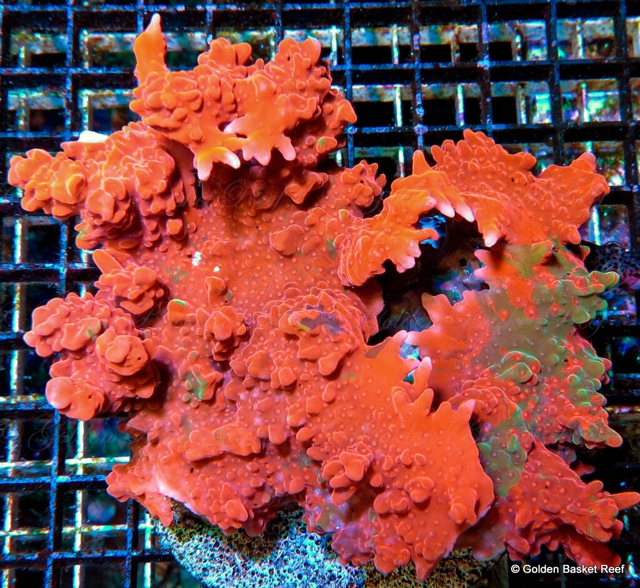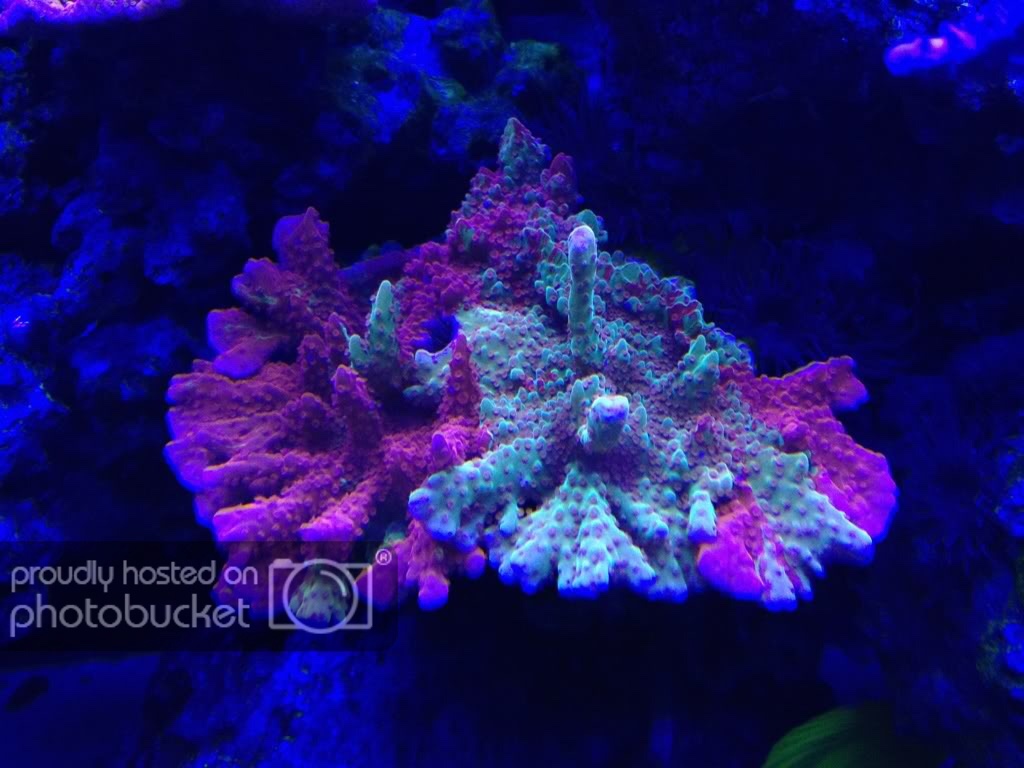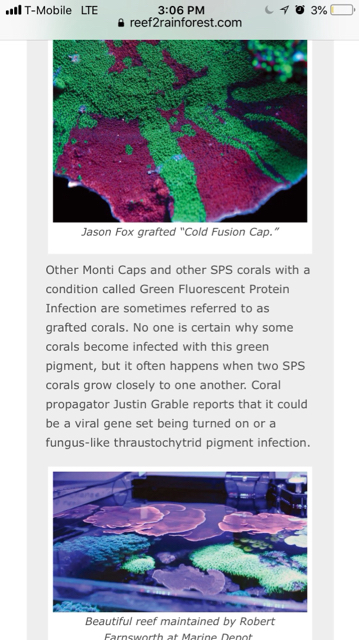Background Classification
All of the hard corals fall under the order, Scleractinia, which falls under the subclass Hexacorallia. Hexacorallia is under the class, Anthozoa, within the phylum, Cnidaria.
So, when we talk about SPS coral, some people say, "small polyp stony" coral, while others say "small polyp Scleractinian coral" which means the same thing. It's worth noting that the terms "SPS" and "LPS" wouldn't be found in any marine biology book as they are terms used exclusively in the reef hobby, but they're useful to hobbyists for discussing different coral types based on characteristics we easily see.

Screenshot courtesy of @Seawitch
There are 15 families that fall under the order, Scleractinia. Acroporidae is the first one. And within Acroporidae is the genus, Montipora.
Orange Setosa (Montipora Setosa)
“The Orange Setosa is an awesome Montipora species with a rather unique growth form among SPS corals. This coral is famous for its intense orange coloration but it can appear pink when placed under very intense lighting. As the Orange Setosa colony grows, it forms an undulating encrusted base and branches that eventually fuse together before branching again. Mature colonies often have extremely unusual shapes and it seems that no two colonies are ever the same. Compared to other Montipora species, the Orange Setosa has very few polyps however they give the otherwise smooth surface a delicate texture. The Orange Setosa is a relatively slow grower, but we have found it to be hardy and tolerant of a wide range of lighting and flow conditions.”
Source: ORA, Orange Setosa (Montipora setosa)
Location:
Indo-Pacific - Montipora have a wide distribution are typically found around the islands of the Indopacific including Fiji, Tonga, Solomon Islands, and the Great Barrier Reef.
Source: Tidal Gardens, Orange Montipora Setosa
Feeding:
Montipora relies heavily on the products of their zooxanthellae but to a lesser degree may feed on phytoplankton and similarly sized microfauna in the water column.
Source: ibid.
Requirements:
Flow: Moderate-High
Lighting: Moderate-High
Placement: Bottom-Middle
(Via: Unique Corals)
Discussion:
What’s the difference between these two corals?
(A)

(B)

Answer: Coral (A) is RTN'd/dead, and coral (B) is thriving. Same tank. One is just a few inches lower on the rockwork than the other but also on the outter edge of the tank where the lighting is less intense. RTN stands for Rapid Tissue Necrosis.
The Orange Setosa is one of my favorite corals. Both of these frags came from the same colony and arrived in great shape. Recommended PAR for these when I purchased them from Unique Corals was 200-250 PAR. While the dead one did really well on my Frag rack for a month, once I mounted it to the liverock where I’d hoped it would thrive, unfortunately, it instead completely RTN'd within the day.
Admittedly, my the lighting on my tank is very intense and likely overkill. I am running 2 AI Hydra 26 HD lights running the Daxby schedule about 14” above the water on an 18” deep 30 falling long tank. PAR in the top center of my tank where most of my acros are is between 380-450 (like I said, pretty intense). While I light acclimated these corals, the 250-300 par where I placed the Orange Setosa ultimately proved to be way too intense for the coral, it RTN'd, and I had to purchase a replacement to make up for the loss. Which is a bummer because I liked the structure of the one I killed a lot more.
I was surprised because I have 3 other Montipora under much more intense lighting in my tank, and every other coral in the tank has great color and polyp extension.
My opinion, and this may be common to others who have had more experience with this coral, is that the Orange Setosa Montipora is a LOW LIGHT SPS coral. It may still be considered high light to true low light corals such as softies, but in comparison to some other light loving Montipora, mine has shown the best color under 150-200 PAR. If you don’t have a PAR reading device, I would suggest starting the coral in a very low light, moderate/high flow area in your tank and slowly move it up to where you want it in the tank while paying very close attention to it once you move it so if it begins to bleach you can move it back to a much lower light area immediately to prevent a loss like the one I had. I’ve found a few other posts on R2R that corroborate my experience and I just wanted to share my experience with you all so that nobody else suffers the same loss I did even when I thought I had acclimated it properly.
~~~~~~~~~~~~~~~
We encourage all our readers to join the Reef2Reef forum. It’s easy to register, free, and reefkeeping is much easier and more fun in a community of fellow aquarists. We pride ourselves on a warm and family-friendly forum where everyone is welcome. You will also find lots of contests and giveaways with our sponsors.
~~~~~~~~~~~~~~~
Author Profile: @LilElroyJetson has been reef keeping for over 5 years and is currently working on his scuba certification. He works as a transactional attorney by day and hopes to begin propagating high end coral exclusively for Reef2Reef members in the near future. His other love along with reef keeping is taking care of his two dogs, Diesel, a precious American Pit Bull, and Louis, a devil-child French Bulldog. His build thread has a link below.
All of the hard corals fall under the order, Scleractinia, which falls under the subclass Hexacorallia. Hexacorallia is under the class, Anthozoa, within the phylum, Cnidaria.
So, when we talk about SPS coral, some people say, "small polyp stony" coral, while others say "small polyp Scleractinian coral" which means the same thing. It's worth noting that the terms "SPS" and "LPS" wouldn't be found in any marine biology book as they are terms used exclusively in the reef hobby, but they're useful to hobbyists for discussing different coral types based on characteristics we easily see.
Screenshot courtesy of @Seawitch
There are 15 families that fall under the order, Scleractinia. Acroporidae is the first one. And within Acroporidae is the genus, Montipora.
Orange Setosa (Montipora Setosa)
“The Orange Setosa is an awesome Montipora species with a rather unique growth form among SPS corals. This coral is famous for its intense orange coloration but it can appear pink when placed under very intense lighting. As the Orange Setosa colony grows, it forms an undulating encrusted base and branches that eventually fuse together before branching again. Mature colonies often have extremely unusual shapes and it seems that no two colonies are ever the same. Compared to other Montipora species, the Orange Setosa has very few polyps however they give the otherwise smooth surface a delicate texture. The Orange Setosa is a relatively slow grower, but we have found it to be hardy and tolerant of a wide range of lighting and flow conditions.”
Source: ORA, Orange Setosa (Montipora setosa)
Location:
Indo-Pacific - Montipora have a wide distribution are typically found around the islands of the Indopacific including Fiji, Tonga, Solomon Islands, and the Great Barrier Reef.
Source: Tidal Gardens, Orange Montipora Setosa
Feeding:
Montipora relies heavily on the products of their zooxanthellae but to a lesser degree may feed on phytoplankton and similarly sized microfauna in the water column.
Source: ibid.
Requirements:
Flow: Moderate-High
Lighting: Moderate-High
Placement: Bottom-Middle
(Via: Unique Corals)
Discussion:
What’s the difference between these two corals?
(A)
(B)
Answer: Coral (A) is RTN'd/dead, and coral (B) is thriving. Same tank. One is just a few inches lower on the rockwork than the other but also on the outter edge of the tank where the lighting is less intense. RTN stands for Rapid Tissue Necrosis.
The Orange Setosa is one of my favorite corals. Both of these frags came from the same colony and arrived in great shape. Recommended PAR for these when I purchased them from Unique Corals was 200-250 PAR. While the dead one did really well on my Frag rack for a month, once I mounted it to the liverock where I’d hoped it would thrive, unfortunately, it instead completely RTN'd within the day.
Admittedly, my the lighting on my tank is very intense and likely overkill. I am running 2 AI Hydra 26 HD lights running the Daxby schedule about 14” above the water on an 18” deep 30 falling long tank. PAR in the top center of my tank where most of my acros are is between 380-450 (like I said, pretty intense). While I light acclimated these corals, the 250-300 par where I placed the Orange Setosa ultimately proved to be way too intense for the coral, it RTN'd, and I had to purchase a replacement to make up for the loss. Which is a bummer because I liked the structure of the one I killed a lot more.
I was surprised because I have 3 other Montipora under much more intense lighting in my tank, and every other coral in the tank has great color and polyp extension.
My opinion, and this may be common to others who have had more experience with this coral, is that the Orange Setosa Montipora is a LOW LIGHT SPS coral. It may still be considered high light to true low light corals such as softies, but in comparison to some other light loving Montipora, mine has shown the best color under 150-200 PAR. If you don’t have a PAR reading device, I would suggest starting the coral in a very low light, moderate/high flow area in your tank and slowly move it up to where you want it in the tank while paying very close attention to it once you move it so if it begins to bleach you can move it back to a much lower light area immediately to prevent a loss like the one I had. I’ve found a few other posts on R2R that corroborate my experience and I just wanted to share my experience with you all so that nobody else suffers the same loss I did even when I thought I had acclimated it properly.
~~~~~~~~~~~~~~~
We encourage all our readers to join the Reef2Reef forum. It’s easy to register, free, and reefkeeping is much easier and more fun in a community of fellow aquarists. We pride ourselves on a warm and family-friendly forum where everyone is welcome. You will also find lots of contests and giveaways with our sponsors.
~~~~~~~~~~~~~~~
Author Profile: @LilElroyJetson has been reef keeping for over 5 years and is currently working on his scuba certification. He works as a transactional attorney by day and hopes to begin propagating high end coral exclusively for Reef2Reef members in the near future. His other love along with reef keeping is taking care of his two dogs, Diesel, a precious American Pit Bull, and Louis, a devil-child French Bulldog. His build thread has a link below.
Last edited:




















